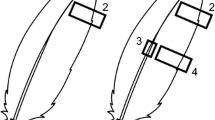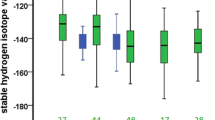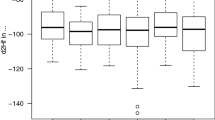Abstract
Continent-wide variation in hydrogen isotopic composition of precipitation is incorporated into animal diets, providing an intrinsic marker of geographic location at the time of tissue growth. Feathers from migratory birds are now frequently analyzed for stable-hydrogen isotopes (δD) to estimate the location of individuals during a preceding molt. Using known-origin birds, we tested several assumptions associated with this emerging technique. We examined hydrogen isotopic variation as a function of age, sex, feather type and the timing of molt in a marked population of American redstarts (Setophaga ruticilla) breeding in southeastern Ontario. We measured δD in feathers and blood from individuals that bred or hatched at our study site during the year in which those tissues were grown. Juvenile tissues from 5- to 10-day-old birds had more negative δD values than those from adults, which most likely reflected age-related differences in diet. Within adults, primary feathers had more negative δD values than contour feathers. The mean δD value in adult primary feathers was relatively consistent among years and with the value expected for our study population. However, among-individual variation in δD corresponded to an estimated latitudinal range of 6–8° (650–900 km). We conclude that feathers sampled from recently hatched juveniles may not provide a reliable estimate of expected local isotopic signatures for comparison with adult feathers of unknown origin. Furthermore, we urge researchers to use caution when using δD values in feathers to infer geographic origin, and suggest that the best approach is to assign individuals to broad geographic zones within a species’ potential molting range.



Similar content being viewed by others
References
Birchall J, O’Connell TC, Heaton THE, Hedges REM (2005) Hydrogen isotope ratios in animal body protein reflect trophic level. J Anim Ecol 74:877–881
Boulet M, Gibbs HL, Hobson KA (2006) Integrated analysis of genetic, stable isotope, and banding data reveal migratory connectivity and flyways in the yellow warbler (Dendroica petechia). In: Boulet M, Norris DR (eds) Migratory connectivity of two species of Neotropical–Nearctic migratory songbirds. Orn Monogr 61
Bowen GJ, Revenaugh J (2003) Interpolating the isotopic composition of modern meteoric precipitation. Water Resour Res 39:1299
Bowen GJ, Wassenaar LI, Hobson KA (2005) Global application of stable hydrogen and oxygen isotopes to wildlife forensics. Oecologia 143:337–348
Epstein S, Yapp CJ, Hall JH (1976) The determination of the D/H ratio of non-exchangeable hydrogen in cellulose extracted from aquatic and land plants. Earth Planet Sci Lett 30:241–251
Estep MF, Dabrowski H (1980) Tracing food webs with stable hydrogen isotopes. Science 209:1537–1538
Gill FB (1989) Ornithology. Freeman, New York
Greenberg R, Marra PP (2005) Birds of two worlds: the ecology and evolution of migration. Johns Hopkins University Press, Baltimore, Md.
Hobson KA (1999) Tracing origins and migration of wildlife using stable isotopes: a review. Oecologia 120:314–326
Hobson KA (2005a) Stable isotopes and the determination of avian migratory connectivity and seasonal interactions. Auk 122:1037–1048
Hobson KA (2005b) Using stable isotopes to trace long-distance dispersal in birds and other taxa. Divers Distrib 11:157–164
Hobson KA, Wassenaar LI (1997) Linking breeding and wintering grounds of neotropicalmigrant songbirds using stable hydrogen isotopic analysis of feathers. Oecologia 109:142–148
Hobson KA, Wassenaar LI (2001) Isotopic delineation of North American migratory wildlife populations: loggerhead shrikes. Ecol Appl 11:1545–1553
Hobson KA, Atwell L, Wassenaar LI (1999) Influence of drinking water and diet on the stable-hydrogen isotope ratios of animal tissues. PNAS 96:8003–8006
Hobson KA, Wassenaar LI, Bayne E (2004) Using isotopic variance to detect long-distance dispersal and philopatry in birds: an example with ovenbirds and American redstarts. Condor 106:732–743
Kelly JF (2006) Stable isotope evidence links breeding geography and migration timing in wood warblers (Parulidae). Auk 123:431–437
Kelly JF, Atudorei V, Sharp ZD, Finch DM (2002) Insights into Wilson’s Warbler migration from analyses of hydrogen stable-isotope ratios. Oecologia 130:216–221
Kelly JF, Ruegg KC, Smith TB (2005) Combining isotopic and genetic markers to identify breeding origins of migrant birds. Ecol Appl 15:1487–1494
Kirkley JS, Gessaman JA (1990) Water economy of nestling Swainson's hawks. Condor 92:29–44
Lajtha K, Michener RH (1994) Stable isotopes in ecology and environmental science. Blackwell, London
Lott CA, Smith JP (2006) A Geographic-Information-System approach to estimating the origin of migratory raptors in North America using stable hydrogen isotope ratios in feathers. Auk 123:822–835
Marder J, Withers PC, Philpot RG (2003) Patterns of cutaneous water evaporation by Australian pigeons. Isr J Zool 49:111–129
Marra PP, Norris DR, Haig SM, Webster MS, Royle JA (2006) Migratory connectivity. In: Crooks K, Sanjayan MA (eds) Conservation connectivity. Cambridge University Press, New York
Mazerolle DF, Hobson KA (2005) Estimating origins of short-distance migrant songbirds in North America: contrasting inferences from hydrogen isotope measurements of feathers, claws, and blood. Condor 107:280–288
McKechnie AE, Wolf BO, Martinez del Rio C (2004) Deuterium stable-isotope ratios as tracers of water use: an experimental test with rock doves. Oecologia 140:191–200
Meehan TD, Lott CA, Sharp ZD, Smith RB, Rosenfield RN, Stewart AC, Murphy RK (2001) Using hydrogen isotope geochemistry to estimate the natal latitudes of immature Cooper’s hawks migrating through the Florida Keys. Condor 103:11–20
Meehan TD, Rosenfield RN, Atudorei VN, Bielefeldt J, Rosenfield LJ, Stewart AC, Stout WE, Bozek MA (2003) Variation in hydrogen stable-isotope ratios between adult and nestling Cooper’s hawks. Condor 105:567–572
Meehan TD, Giermakowski JT, Cryan PM (2004) GIS-based model of stable hydrogen isotope ratios in North American growing-season precipitation for use in animal movement studies. Isotopes Environ Heath Stud 40:291–300
Norris DR, Marra PP, Montgomerie R, Kyser TK, Ratcliffe LM (2004) Reproductive effort, molting latitude, and feather color in a migratory songbird. Science 306:2249–2250
Norris DR, Wunder MB, Boulet M (2006a) Perspectives in migratory connectivity. In: Boulet M, Norris DR (eds) Migratory connectivity of two species of Neotropical–Nearctic migratory songbirds. Orn Monogr 61
Norris DR, Marra PP, Bowen GJ, Ratcliffe LM, Royle JA, Kyser TK (2006b) Migratory connectivity of a widely distributed songbird, the American Redstart (Setophaga ruticilla). In Boulet M, Norris DR (eds) Migratory connectivity of two species of Neotropical–Nearctic migratory songbirds. Orn Monogr 61
Powell LA, Hobson KA (2006) Enriched feather hydrogen isotope values for Wood Thrushes sampled in Georgia, USA, during the breeding season: implications for quantifying dispersal. Can J Zool 84:1331–1338
Pyle P (1997) Identification guide to North American birds. Part I. Slate Creek Press, Bolinas
Rocque DA, Ben-David M, Barry RP, Winker K (2006) Assigning birds to wintering and breeding grounds using stable isotopes: lessons from two feather generations among three intercontinental migrants. J Ornithol 147:395–404
Royle JA, Rubenstein DR (2004) The role of species abundance in determining breeding origins of migratory birds with stable isotopes. Ecol Appl 14:1780–1788
Rubenstein DR, Hobson KA (2004) From birds to butterflies: animal movement patterns and stable isotopes. Trends Ecol Evol 19:256–263
Rubenstein DR, Chamberlain CP, Holmes RT, Ayres MP, Waldbauer JR, Graves GR, Tuross NC (2002) Linking breeding and wintering ranges of a migratory songbird using stable isotopes. Science 295:1062–1065
SAS Institute (2006) JMP Statistical Discovery 6.0.2. Duxbury, Pacific Grove, Calif.
Sherry TW, Holmes RT (1997) American redstart (Setophaga ruticilla). In: Poole A, Gill FB (eds) The birds of North America, no. 277. Academy of Natural Science, Philadelphia, American Ornithological Union, Washington, D.C.
Smith AD, Dufty AM Jr (2005) Variation in the stable-hydrogen isotope composition of Northern Goshawk feathers: relevance to the study of migratory origins. Condor 107:547–558
Smith BN, Epstein S (1970) Biogeochemistry of the stable isotopes of hydrogen and carbon in salt marsh biota. Plant Physiol 46:738–742
Smith TB, Marra PP, Webster MS, Lovette I, Gibbs HL, Holmes RT, Hobson KA, Rohwer S (2003) A call for feather sampling. Auk 120:218–221
Wassenaar LI, Hobson KA (2001) A stable-isotope approach to delineate geographical catchment areas of avian migration monitoring stations in North America. Environ Sci Technol 35:1845–1850
Webster MS, Marra PP, Haig SM, Bensch S, Holmes RT (2002) Links between worlds: unraveling migratory connectivity. Trends Ecol Evol 17:76–83
Wolf BO, Walsberg GE (1996) Respiratory and cutaneous evaporative water loss at high environmental temperatures in a small bird. J Exp Biol 199:451–457
Wunder MB, Kester CL, Knopf FL, Rye RO (2005) A test of geographic assignment using isotope tracers in feathers of known origin. Oecologia 144:607–617
Acknowledgements
Funding was provided by the Natural Sciences and Engineering Research Council of Canada (L. M. R., T. K. K., K. M. L., D. R. N.), the National Science Foundation (0089565; P. P. M.), the Canadian Foundation for Innovation (T. K. K., L. M. R.), the Wilson Ornithological Society (D. R. N.), Sigma Xi (M. W. R.), the American Ornithologists’ Union (M. W. R., D. R. N.), the Society of Canadian Ornithologists (M. W. R., D. R. N.), the Ontario Government (K. M. L.), Queen’s University (M. W. R., D. R. N.) and the Smithsonian Institution (P. P. M.). Thanks to C. Studds, S. McWilliams, J. Kelly and one anonymous reviewer for helpful comments, to F. Phelan and F. Connor for logistical support at the Queen’s University Biological Station, to K. Klassen and A. Vuletich for assistance with isotope analysis, to K. Shorter and R. Zavitz for collecting and analyzing water samples, to C. Hasler for GIS help, and to our many excellent field crews for their tireless efforts.
Author information
Authors and Affiliations
Corresponding author
Additional information
Communicated by Mark Chappell.
Rights and permissions
About this article
Cite this article
Langin, K.M., Reudink, M.W., Marra, P.P. et al. Hydrogen isotopic variation in migratory bird tissues of known origin: implications for geographic assignment. Oecologia 152, 449–457 (2007). https://doi.org/10.1007/s00442-007-0669-3
Received:
Accepted:
Published:
Issue Date:
DOI: https://doi.org/10.1007/s00442-007-0669-3




